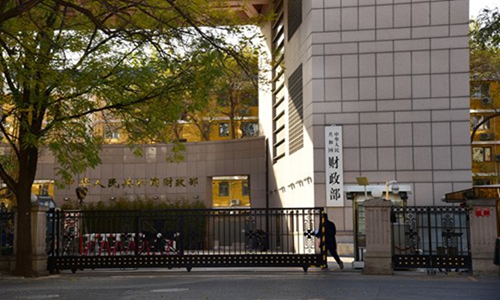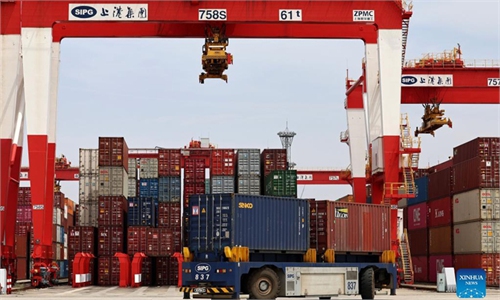10 years on, China makes bigger fiscal 'cake' in staunch push for sound economic growth

Ministry of Finance in Beijing Photo: VCG
Over the past decade since a key Party plenum in 2012, China has succeeded in making a bigger fiscal "cake," with an average annual gain of 6.9 percent in its fiscal revenue, Vice Finance Minister Xu Hongcai said on Tuesday.The country's increased fiscal capacity, adding to its unwavering push for fiscal and taxation reforms as part of a comprehensive deepening of reforms, is shown to have propped up the economy and improved the quality of economic growth, the ministry said.
An expanded value added tax (VAT) refund policy, a viable outcome of the country's fiscal and tax overhauls, was revealed to have played an effective part in coping with the downward pressure on the economy amid the domestic Omicron resurgence, according to the ministry, defusing woes over a fiscal revenue drop for the first four months.
Buoyed by the country's well-functioning fiscal apparatus, experts were bullish on the reasonable and effective use of government spending to underpin the economy in a haze of uncertainties. They also allayed concerns over local government debt and the flagging real estate sector, citing the decent job the country has over the years done in managing local government debt risks and achieving an economic rebalancing away from property-fueled growth.
Bigger fiscal 'cake'
Since the 18th National Congress of the Communist Party of China (CPC) in 2012, the country's public fiscal income totaled 163.05 trillion yuan ($24.08 trillion) over the past 10 years, with an average annual growth of 6.9 percent, Xu told a press conference in Beijing on Tuesday.
Last year, China's general fiscal revenue grew to 20.25 trillion yuan from 11.73 trillion yuan in 2012. During the same period, fiscal expenditure totaled 193.64 trillion yuan, with an average annual growth of 8.5 percent, providing solid financial support for achieving the first centenary goal of building a moderately prosperous society in all respects, Xu said.
The numbers speak volumes about the rise of China's fiscal strength, central to the country's sound economic growth over the past decade.
In 2021, China's GDP hit 114 trillion yuan, accounting for upwards of 18 percent of the world's total, official data showed. This compares with 11.4 percent in 2012.
Over the past decade, China's fiscal macro-adjustment has been continuously improved. The nation's proactive fiscal policy, combined with timely and appropriate adjustment and fine-tuning, has effectively reduced the impact of business cycle fluctuations and strongly supported high-quality economic and social development, Xu said.
China has maintained the intensity of necessary government spending and ensured that major national strategic tasks were met. Additionally, well-targeted measures have been implemented to cut taxes and administrative fees, reducing the burden on businesses by 8.8 trillion yuan from 2013 to 2021, Xu noted.
From 2015 to 2021, an additional 12.2 trillion yuan of special bonds for local governments were issued to support the expansion of government investment.
Fiscal and taxation reforms were also in focus at Tuesday's press conference, with the vice finance minister describing the reform efforts over the past decade as a "breakthrough" in the country's comprehensive deepening of reforms, which helps in maintaining economic operations within a reasonable range while improving the quality of economic development.
As one main theme of China's macro-adjustment, reform of the fiscal and taxation system has been directing the growth of the economy and safeguarding the development from crises, Cong Yi, a professor at the Tianjin University of Finance and Economics, told the Global Times on Tuesday.
Fiscal policies have focused on reducing the tax burdens of businesses, facilitating innovation and industrial upgrading. With the external environment becoming more complex, such as the Trump administration's tariffs war against China and the COVID-19 pandemic, the government's fiscal income and expenditure have played a more significant role to improve people's welfare, ensure employment and maintain economic growth, Cong said.
Among the most watched-for moves is an expanded input VAT credit refund policy that is being relied on to bail out businesses amid a slowing economy.
The VAT refund policy was unveiled in 2019 as the country moved to deepen VAT tax reforms. Input VAT credit refers to the credit that a business receives from VAT payment on a purchase which it can use to lower its tax liability on a sale.
Under the policy, taxpayers meeting certain criteria can apply for the refund of uncredited input VAT.
VAT refund-induced decline
The tax refunds and cuts would hit approximately 2.5 trillion yuan for the whole of the year, with the VAT credit refund totaling 1.5 trillion yuan, Xu said.
While offering a helping hand to businesses, the VAT credit refund would result in decreased fiscal revenue, he said, explaining that the credit refund is recorded in the balance sheet as a reduction of revenue rather than fiscal subsidies or expenditure.
The VAT credit refund for April alone amounted to about 800 billion yuan, beating previous estimates, the vice finance minister said, around 37.5 percent of that for last April.
Newly added credits are scheduled to be fully refunded on a monthly basis beginning April.
That suggests the country's fiscal revenue would have fallen 37.5 percent due to the refund implementation, he said, adding that the decline would be even heftier in the regions with advanced manufacturing, especially some provinces in the eastern part of the country.
The country's fiscal revenue stood at 7.43 trillion yuan in the first four months, down 4.8 percent year-on-year, per official numbers.
If deducing the effect of the VAT credit refund, national fiscal revenue posted an increase of 5 percent during the period. The gain eased from an 8.6 percent increase for the first quarter.
Apart from the influence from VAT tax cuts, China also has other forms of tax and fee reduction policies amounting to about 1 trillion yuan. Those tax decreases, along with other tax policies, have eaten into the country's fiscal income in the first four months.
Local governments also spent more money during the period to safeguard economic growth.
Xu stressed that the central government has made up for the local government fiscal income reduction with methods like transfer payments, and the remedy has been in place in general.
According to him, the income reduction reflects voluntary action of using positive fiscal policies to cope with economic downward pressure, and as the fundamentals of stable and long-term improvement of China's economy have not changed, local government fiscal income will rebound stably along with the effects of coordinating epidemic control and economic development.
Fiscal resilience expected
Against the backdrop of the pandemic and the increasingly fluctuating external economic environment, there are mounting pressures from both fiscal income shrinkage and expenditure increases.
For starters, governmental departments need to tighten their belts more and practice austerity to cope with the fiscal income pressure brought about by the pandemic, Jia Kang, director of the China Academy of New Supply-side Economics, told the Global Times on Tuesday.
While in the medium and long term after putting the epidemic under control, it is crucial to lead the economy to tackle downward pressure and release growth potential, so as to further support the future growth of fiscal revenue, Jia said.
"When it comes to expenditure, the core is to serve the overall interests of the country, highlight major expenditure projects and then cover normal sectors," he said.
Recent statistics show that financial departments at all levels have stepped up efforts to implement proactive fiscal policies. In the first two months, the progress of budgetary expenditure was 14.3 percent, the highest in the past five years, according to data from the Ministry of Finance.
Local government special bonds are an important tool for implementing proactive fiscal policies, and one of the most direct and effective policy tools for the government to stimulate investment.
The quota of local special bonds for project construction has been fully issued, totaling about 1.25 trillion yuan by the end of March. At present, local governments have reserved 71,000 special bond projects, Xu said during a press conference on April 12.
On the other hand, debt ratios of local governments have been under close scrutiny in recent years. The overall local government debt ratio was 93.6 percent in 2020, although not a high level compared to international standards which range from 100 percent to 120 percent.
It is the implicit debt which needs to be well controlled. Yet, there is no catch-all pattern to assess a local government's debt situation, Jia said, noting that a relative high debt level does not necessarily mean a bad thing for certain places.
In recent months, local governments have rolled out different policies within the real estate sector, raising voices that believe China is easing housing policies as the sector used to be a main source of local fiscal revenues.
On May 9, China's central bank said the real estate sector will not be used to provide short-term stimulus. Local governments are supported to make tailored policies to promote the healthy development of the sector, but the principle will not change as "houses are for living in, not for speculation."
The nominal fiscal deficit rate is only 2.8 percent this year, there remains room for China to further adjust its fiscal structure when it is necessary, Jia said.
Despite the challenges, China is able to further implement proactive fiscal policies to improve people's livelihood and ensure the stable growth of the economy, experts said.


